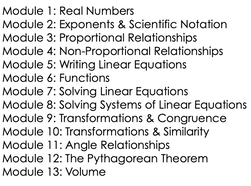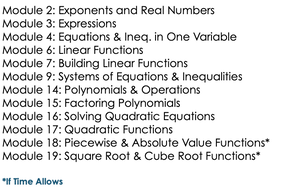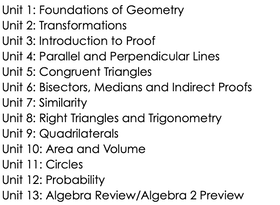Middle School is a year of big change from the traditional one teacher model of elementary school to the mutiple teacher model. Due to this change, middle school can sometimes be a difficult adjustment for students during the first trimester. It is very importnat that during this time parents and students work with teachers to ensure success.
One major difference in middle school is the importance of building strong study skills and accountability for the academic learning. Students are expected to take notes and think critically as well as be able to apply their knowledge to high-level problems. Througout the year students are expected to monitor their own grades and assignments. It is a students's responsibility to discuss grades with teachers and make the necessary adjustments that will help them succeed.
With the onset of National and State Common Core Standards, students will be expected to be able to explain their mathematical thought process. Students will be required to use critical thinking and apply their understanding of concepts to high-level problems as well as determine the reasonableness of their answers.
My philosophy in math is that students will learn to be true mathematicians in the sense that they will not only work out problems to obtain the right answer, but also be able to express their thinking and communicate their ideas. I encourage students to ask questions and always approach math with an open mind. It is fine to make mistakes as long as we learn from them and it is fine to question and try various approaches to solving problems. Yes, in math their is usually one right answer, but there are many ways to arrive at that answer. It is my goal for every student to build a strong foundational understanding of mathematics rather that simply learning algorithms so that they are better prepared to tackle the more abstract branches of math they will face in future years of school.
Mr. J. Uribe Back
One major difference in middle school is the importance of building strong study skills and accountability for the academic learning. Students are expected to take notes and think critically as well as be able to apply their knowledge to high-level problems. Througout the year students are expected to monitor their own grades and assignments. It is a students's responsibility to discuss grades with teachers and make the necessary adjustments that will help them succeed.
With the onset of National and State Common Core Standards, students will be expected to be able to explain their mathematical thought process. Students will be required to use critical thinking and apply their understanding of concepts to high-level problems as well as determine the reasonableness of their answers.
My philosophy in math is that students will learn to be true mathematicians in the sense that they will not only work out problems to obtain the right answer, but also be able to express their thinking and communicate their ideas. I encourage students to ask questions and always approach math with an open mind. It is fine to make mistakes as long as we learn from them and it is fine to question and try various approaches to solving problems. Yes, in math their is usually one right answer, but there are many ways to arrive at that answer. It is my goal for every student to build a strong foundational understanding of mathematics rather that simply learning algorithms so that they are better prepared to tackle the more abstract branches of math they will face in future years of school.
Mr. J. Uribe Back
Math 7
In Math 7, students will focus on four critical areas: (1) developing understanding of and applying proportional relationships; (2) developing understanding of operations with rational numbers and working with expressions and linear equations; (3) solving problems involving scale drawings and informal geometric constructions, and working with two- and three-dimensional shapes to solve problems involving area, surface area, and volume; and (4) drawing inferences about populations based on samples. Students will also be required to write their understanding of mathematical concepts and delve deeper into the standards for Mathematical Practice. See Ms. Kim For further details.
Math 7 Accelerated
In Math 7 Accelerated, students will be covering 7th and 8th grade standards. Time will be spent on four critical areas: (1) developing understanding of and applying proportional relationships; (2) developing understanding of operations with rational numbers and formulating and reasoning about expressions and equations, including modeling an association in bivariate data with a linear equation, and solving linear equations; (3) grasping the concept of a function and using functions to describe quantitative relationships; and (4) solving problems involving scale drawings and informal geometric constructions and understanding and applying the Pythagorean Theorem. In addition, students will be required to articulate their understanding of math concepts through informal proofs and writing as well as use the standards for Mathematical Practice.
See Ms. Kim For further details.
See Ms. Kim For further details.
Math 8
In Grade 8, students will focus on three critical areas: (1) formulating and reasoning about expressions and equations, including modeling an association in bivariate data with a linear equation, and solving linear equations and systems of linear equations; (2) grasping the concept of a function and using functions to describe quantitative relationships; (3) analyzing two- and three-dimensional space and figures using distance, angle, similarity, and congruence, and understanding and applying the Pythagorean Theorem. In addition, students will be required to articulate their understanding of math concepts through informal proofs and writing as well as use the standards for Mathematical Practice.
TENTATIVE PACING
Algebra
The main purpose of Algebra I is to develop students’ fluency with linear, quadratic and exponential functions. The critical areas of instruction involve deepening and extending students’ understanding of linear and exponential relationships by contrasting them with each other and by applying linear models to data that exhibit a linear trend. In addition, students engage in methods for analyzing, solving, and using exponential and quadratic functions. Some of the overarching ideas in the Algebra I course include: the notion of function, solving equations, rates of change and growth patterns, graphs as representations of functions, and modeling. Students will also be required to write their understanding of mathematical concepts and delve deeper into the standards for Mathematical Practice.
TENTATIVE PACING
Geometry
Geometry is a very challenging and fast-paced course with a focus on preparing students for Trigonometry/Algebra II. Students will be expected to do more problem solving and mathematical reasoning with a strong focus on proofs. The fundamental purpose of the Geometry course is to introduce students to formal geometric proof and the study of plane figures, culminating in the study of right triangle trigonometry and circles. The correspondence between the plane and the Cartesian coordinate system is explored when students connect algebraic concepts with geometric ones. Students explore probability concepts and use probability in real-world situations. The major mathematical ideas in the Geometry course include geometric transformations, proving geometric theorems, congruence and similarity, analytic geometry, right-triangle trigonometry, and probability.
TENTATIVE PACING


